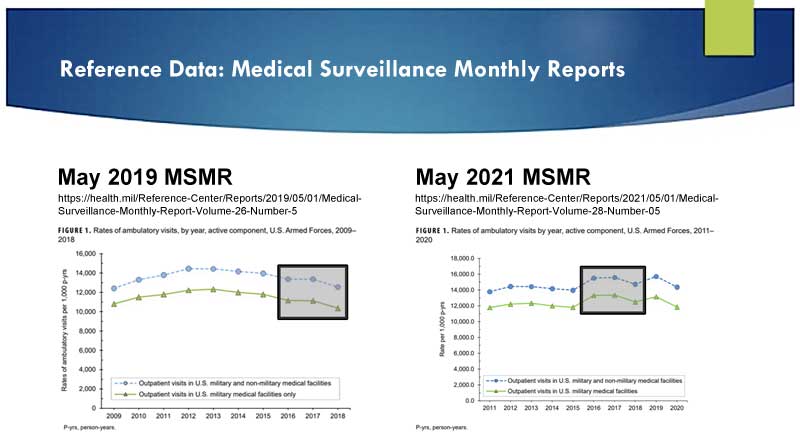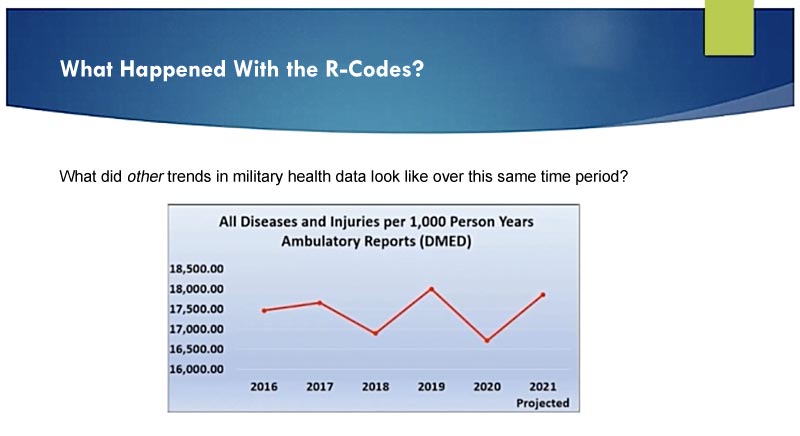
This story is about what could turn out to be one of the biggest cases of medical data fraud. It is based on my conversation with Mathew Crawford, whom I had the pleasure of interviewing for my podcast.
Mathew’s background is in statistics, actuarial sciences and math. In the past, he has worked on Wall Street, then focused on the field of education, writing textbooks and helping build educational companies.
Mathew started looking out for a large-scale dramatic event before the pandemic was announced. He became alarmed when right on the tail of the repo market crisis that happened in the fall of 2019, the Federal Reserve loaned $4.5 trillion to just three banks. (The Fed “quietly released the names of the three banks” who received the loans on December 31, 2021.)
Therefore, as soon as the unusually irrational and economically peculiar “COVID response” was thrown at us, Mathew became suspicious of the “pandemic clownery.”
The Convoluted DoD Data Saga
This particular DoD data saga started unveiling in January 2022, when attorney Thomas Renz presented his whistleblower data at the five-hour hearing held by Senator Ron Johnson.
In his Substack post from February 2022, Mathew described being “shocked listening to Renz in real time” and learning about “the DoD whistleblowers (Drs. Samuel Sigoloff, Peter Chambers, and Theresa Long) or the startling findings from the Defense Medical Epidemiology Database (DMED):
- Miscarriages up ~300%
- Cancer rates up ~300%
- Neurological conditions up ~1000%
Renz makes the database publicly downloadable here.” From there, the things got complicated. And before we dig in, let us first identify the elephant in the room.
The Elephant in the Room: A Summary
After Tom Renz made his earth-shaking announcement, the DoD came out and said that they had experienced a server glitch, and therefore, the whistleblower data was no good.
And as the DoD was hiding behind the unsigned statement about a “server glitch,” Mathew Crawford went ahead and analyzed a set of publicly available but obscure industry reports sourced from that same DoD database (DMED).
Having looked at the reports, he found that by the time the brave whistle blowers queried the DMED data, the data might have been already corrupted twice, using two different methods — potentially covering up vaccine injury in a very tricky way. (We’d need to look at the original data in order to know for sure what happened.)
Mathew believes that most likely, somebody at the DoD noticed elevated levels of illness in the 2021 data — after all, that’s what the whistleblower doctors have been seeing on the ground — and decided cover it up.
He thinks that the main coverup was done by retroactively changing the data in DMED for the previous years (2016 through 2020, which was done mid-2021, somewhere between May and July 2021, before Tom Renz’s announcement), thus making earlier years look worse than they were, in a number of categories.
But then in addition to that, the already altered database was migrated to a new server, possibly to make it more difficult to investigate. Per Mathew, it is theoretically possible that the in the process of migration, there was a genuine glitch — or maybe there was an intentional glitch to create more confusion and discredit any future whistle blowers.
Mather’s main point is that even if there was a glitch, that glitch likely came on top of the already faked data — and that is what he is trying to scream from the rooftops about.
And amazingly, if there really was a glitch during the sever migration (around August 2021), it went unnoticed for five months — in the military — despite the fact that the data was used by the DoD for troop preparedness evaluation, and also internally used by the CDC. No big deal, I guess.
No one looked, and no one noticed for at least five months that the data for previous years had undergone dramatic changes! I say, believe the DoD. They are trustworthy and would never lie to us. Here is the early timeline, as a direct quote from Mathew:
|
In January, Renz testified on behalf of the whistleblowers. |
|
Several days later, still in January, the DoD took DMED offline. The data was updated dramatically, and the DoD claimed the glitch story with no other explanation. |
|
On February 14, I spot the ahistorical DMED data manipulation in the MSMR. The DoD likely never expected anyone to look through those old reports and check all the past reports to full summarize the DMED data history. At this point, only Renz and I know this level of detail, though I had only superficially laid out what I found to him at that point. |
|
On February 15, the DoD makes the unsigned claim of the server migration introducing the glitch, and gets admonished by a judge for not having an expert witness backing their claims. |
|
March 11, Renz sends a 193-page report to Congress that includes my one-page affidavit about the likely DMED manipulation. It is likely that nobody at the CDC or DoD read that part at the time. |
|
March 22, I published my first article about what I found. The DoD probably isn’t paying attention. |
|
On April 6, I included the MSMR manipulations in my summary of all the dirty data in my talk during the VRBPAC meeting. It has been reported to me that right around that time, the 2016-2020 data suddenly goes offline again (the rest of the database seems available) in DMED! |
Below is the general timeline, according to what Mathew told me in the interview (I have published a version of this timeline here):
The Timeline and the General Plot
|
The Department of Defense maintains a medical database called DMED. The database records various military medical events. It does not record mortality data. |
|
In addition to privately maintaining DMED, they also publish an obscure industry journal called “Medical Surveillance Monthly Reports.” The numbers published in MSMR are based on the same DoD database, DMED. The reports are publicly available. |
|
Every year, usually around May, as a part of MSMR, they publish yearly totals for the previous year and for several preceding years. The reports go over various categories of data, based on medical billing codes. |
|
When in 2021 they published their yearly totals, the historical data for previous years was changed from what it had previously been. (For example, the 2016 numbers published in 2021 were suddenly different from the 2016 numbers published earlier, etc.) Doing so changed the point of reference for the 2021 numbers. However, contrary to the usual practice of data analysis, no explanation for the change was provided. See Mathew’s graph below, made on the basis of the MSMR data: 
|
|
The 2021 data (which Mathew believes nobody had bothered to falsify on a massive scale while the data was still coming in) shows an elevated signal for various medical events, distributed among a range of categories of medical billing codes. |
|
Curiously, “Bell’s Palsy” is a category that does not show an increase in 2021, which looks like an anomaly if compared to the data from other parts of the world. |
|
Around August 2021, the DoD migrated the DMED database to a new server. Mathew believes that in the process, the data was corrupted for the second time, and it is unknown whether the additional layer of corruption was added by accident, or whether it was added to create confusion. It looks like as a result of the server migration, the numbers for earlier years were lowered again — but in a way that doesn’t make them identical or close to the numbers that were previously reported through MSMR. |
|
Meanwhile, in no relation to any of this, several doctors in the military have bravely blown the whistle on the unusual levels of illness they were observing among the service members, with potential attribution to the COVID injections. |
|
In an explosive statement, attorney Tom Renz revealed that he had whistleblower data queried from DMED, and that the data was showing a very large increase in health issues in 2021. (See also Sen. Ron Johnson roundtable). |
|
Mathew believes that the whistleblowers queried the data after two levels of corruption of the database had already occurred — so that data was essentially garbage, and the DoD might have set up the trap on purpose — but at the time, nobody knew that — and the courageous whistleblowers thought they were accessing authentic data. |
|
A few days after that, the DoD issued a vague, unsigned statement through PolitiFact saying that there had been a server glitch, and therefore the whistleblower data was no good. |
|
That statement invoked a heated reaction. Those who believed in “safe and effective vaccines” believed the DoD, and the “hesitant” ones assumed the DoD was lying about the glitch. |
|
But according to Mathew, the argument about the server glitch is a trap because the real fraud most likely happened earlier, in 2021, before the server migration. The server glitch only added an extra layer of confusion. |
|
A notable fact: the “glitch” happened around August 2021 — and for several months, nobody noticed. That, despite the fact that the data was used to evaluate troop readiness, and was also internally studied by the CDC. |
|
Mathew believes that this could be one of the largest medical data frauds of our times. |
|
An added bonus: bizarrely, according to the “post-glitch” data, the U.S. military had no health crisis in 2020: 
|
What Now?
Mathew hopes that a number of attorneys file FOIA requests and try to get a hold of the original data. This is not an easy task by any stretch of imagination. The data could be classified — and per Mathew, opening it up to the public could even require an Act of Congress.
But on the other hand, if the DoD bureaucrats are honest — which of course they are because they would never lie to us — and if they are already publishing their data in an industry journal, and if the injections are safe and effective, what do they have to hide?
Importantly, Mathew is encouraging interested parties to independently look at the MSMR data and draw their own conclusions. The data is publicly available.
On my end, I feel like we should try every avenue to establish the truth. At this point, our legal system is a little bit shaky but it’s still functioning — and I hope that more and more people start thinking from the inside and asking questions. I also hope that qualified attorneys file those FOIA requests, and we start getting somewhere. And yes, we might need a miracle but miracles follow love and courage. Time for love and courage is now.
About the Author
To find more of Tessa Lena’s work, be sure to check out her bio, Tessa Fights Robots.